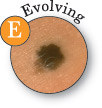
The end of the month is approaching fast, but before it’s gone, I want to remind you that May is Melanoma Skin Cancer Detection and Prevention Month. When you think “cancer,” you may not think “skin cancer” right off the bat, but you should, for it’s the most common cancer and melanoma is the deadliest form of skin cancer.
According to the American Academy of Dermatology, three types of skin cancer account for nearly 100 percent of all diagnosed cases: basal cell carcinoma (BCC), squamous cell carcinoma (SCC) and melanoma. Actinic keratosis (AK) is the earliest form of skin cancer.
You can help prevent melanoma
Don’t let melanoma sneak up on you. Remember that in massive doses or much less, the sun is not your friend and so, to help prevent melanoma…
- Stay out of the sun between 10 a.m. and 4 p.m.
- Use sunscreen with SPF 15 or higher.
- Cover up with long sleeves and a hat.
- Check your skin regularly for changes. If you can’t “see yourself all over,” get your partner, spouse or friend to do this. And ask your healthcare provider to check you during your annual exam—if he or she sees something suspicious, you’ll be referred to a dermatologist. Find a free skin cancer screening here.
More facts:
- Current estimates are that one in five Americans will be diagnosed with skin cancer in their lifetime.
- Melanoma is the most common cancer for 25- to 29-year-olds. Your kids and grandkids need to know about this, and there’s no better time to share your knowledge and concern than now, as summer fast approaches. You can probably show them how the sun has affected you.
“Spot on” treatments

I’ve written previously here about skin cancer. Recently, for cosmetic reasons, my dermatologist removed several AKs from my arms with liquid nitrogen—they are ugly, and worse yet, they can be precancerous. The treatment stings briefly and then the skin falls off in a week or two—the culprit again was too much sun.
It can feel overwhelming to hide from the giant fireball in the sky. A little knowledge about how to protect ourselves can go a long way toward helping us live longer and better. And we can do our best to help prevent melanoma. Happy holiday!
(Photos courtesy: American Academy of Dermatology)